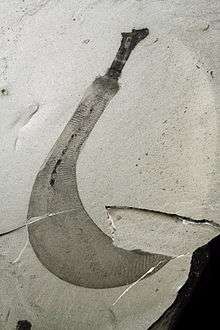Scalidophora
| Scalidophora | |
|---|---|
 | |
| Ottoia prolifica from the Walcott Quarry of the Burgess Shale (Middle Cambrian) near Field, British Columbia, Canada. | |
| Scientific classification | |
| Kingdom: | Animalia |
| Superphylum: | Ecdysozoa |
| Clade: | Scalidophora Lemburg, 1995 |
| Phyla | |
| |
| Synonyms | |
|
Cephalorhyncha, Priapozoa | |
Scalidophora is a group of marine pseudocoelomate protostomes that was proposed on morphological grounds to unite three phyla: the Kinorhyncha, the Priapulida and the Loricifera.[2][3] The three phyla have four characters in common — chitinous cuticle that is moulted, rings of scalids on the introvert, flosculi, and two rings of introvert retracts.[4] However, the monophyly of the Scalidophora is not supported by molecular studies, where the position of the Loricifera was uncertain[2] or as sister to the Panarthropoda.[3] Both studies supported a reduced Scalidophora comprising the Kinorhyncha and Priapulida as sister phyla. Their closest relatives are the Panarthropoda, Nematoda and Nematomorpha; thus they are placed in the group Ecdysozoa.
The two species in the genus Markuelia, known from fossilized embryos from the middle Cambrian, are thought to be stem Scalidophorans.
The group has also been considered a single group, Cephalorhyncha,[5] with three classes.
The group is named after the spines (scalids) covering the introvert (head that can be retracted into the trunk).[6]
References
- ↑ Harvey, T. H.; Dong, X.; Donoghue, P. C. (March–April 2010). "Are palaeoscolecids ancestral ecdysozoans?". Evolution & Development. 12 (2): 177–200. doi:10.1111/j.1525-142X.2010.00403.x. PMID 20433458.
- 1 2 Telford, M. J.; Bourlat, S. J.; Economou, A.; Papillon, D.; Rota-Stabelli, O. (27 April 2008). "The evolution of the Ecdysozoa" (pdf). Philosophical Transactions of the Royal Society B. 363 (1496): 1529–1537. doi:10.1098/rstb.2007.2243. PMC 2614232. PMID 18192181.
- 1 2 Yamasaki, Hiroshi; Fujimoto, Shinta; Miyazaki, Katsumi (2015-06-30). "Phylogenetic position of Loricifera inferred from nearly complete 18S and 28S rRNA gene sequences". Zoological Letters. 1: 18. doi:10.1186/s40851-015-0017-0. ISSN 2056-306X.
- ↑ Heiner, I., Kristensen, R.H. 2005. Two new species of the genus Pliciloricus (Loricifera, Pliciloricidae) from the Faroe Bank, North Atlantic. Zoologischer Anzeiger. 243: 121–138.
- ↑ Dirnberger, J. "Explanations and Difficulties in Invertebrate Phylogeny". Invertebrate Zoology. Kennesaw State University. Retrieved 2012-08-11.
- ↑ Dunn, C. W.; Hejnol, A.; Matus, D. Q.; Pang, K.; Browne, W. E.; Smith, S. A.; Seaver, E.; Rouse, G. W.; Obst, M.; et al. (10 April 2008). "Broad Phylogenomic Sampling Improves Resolution of the Animal Tree of Life". Nature. 452 (7188): 745–749. doi:10.1038/nature06614. PMID 18322464.